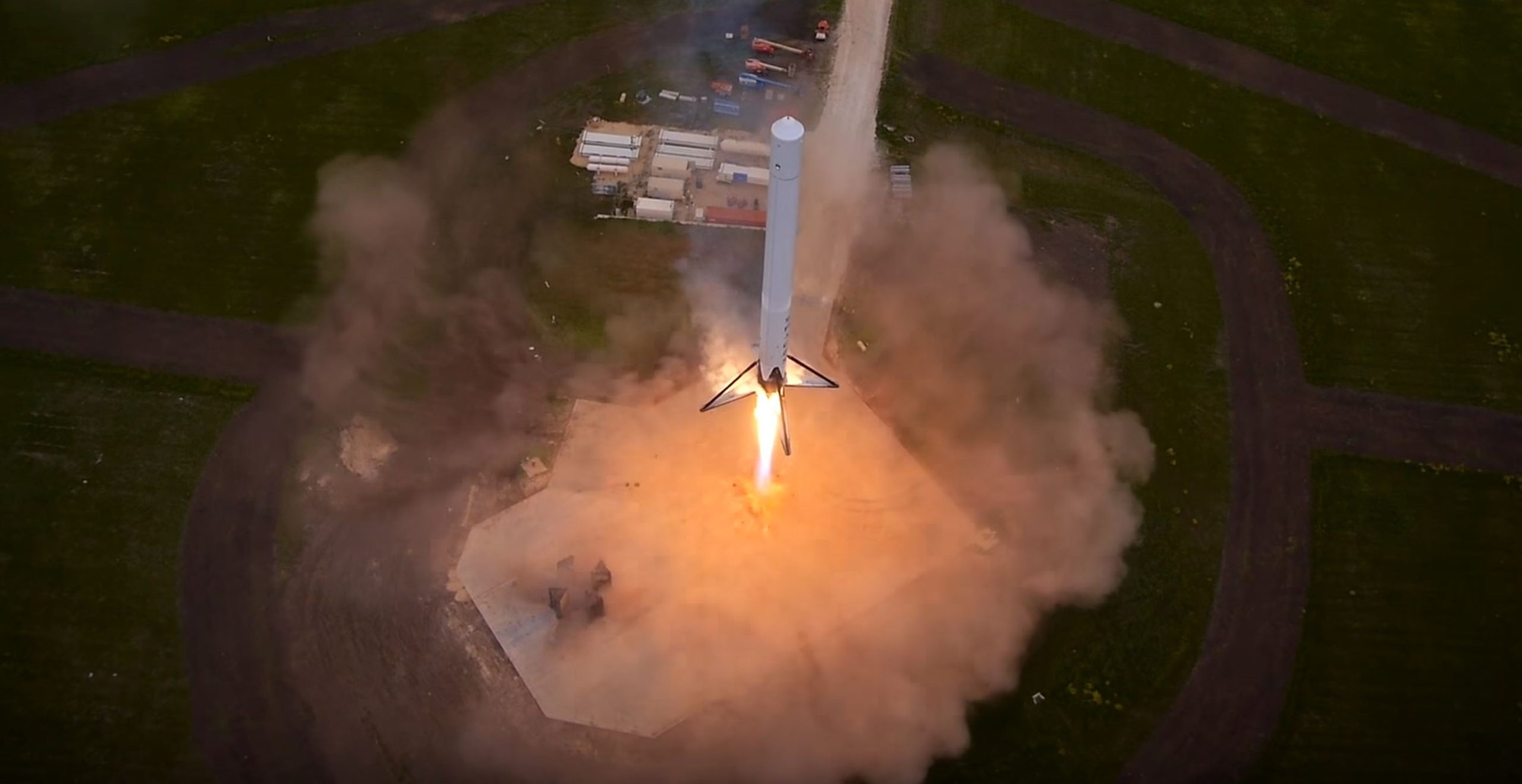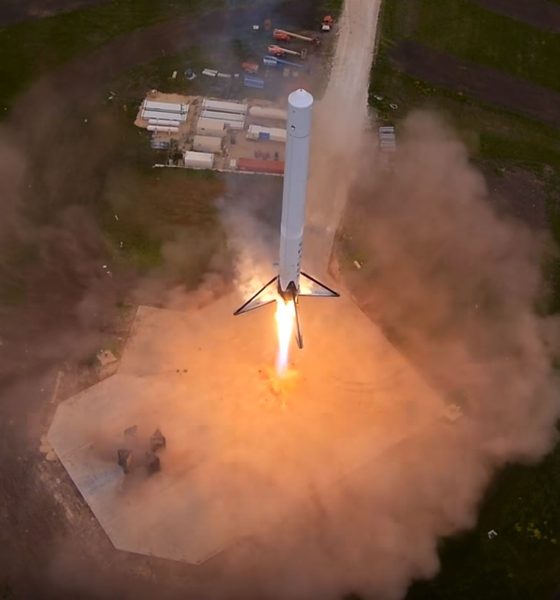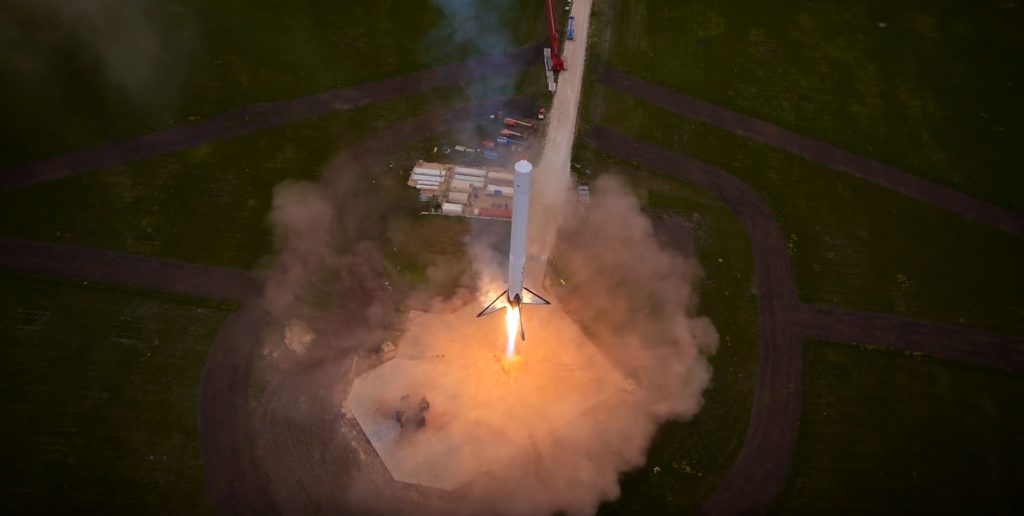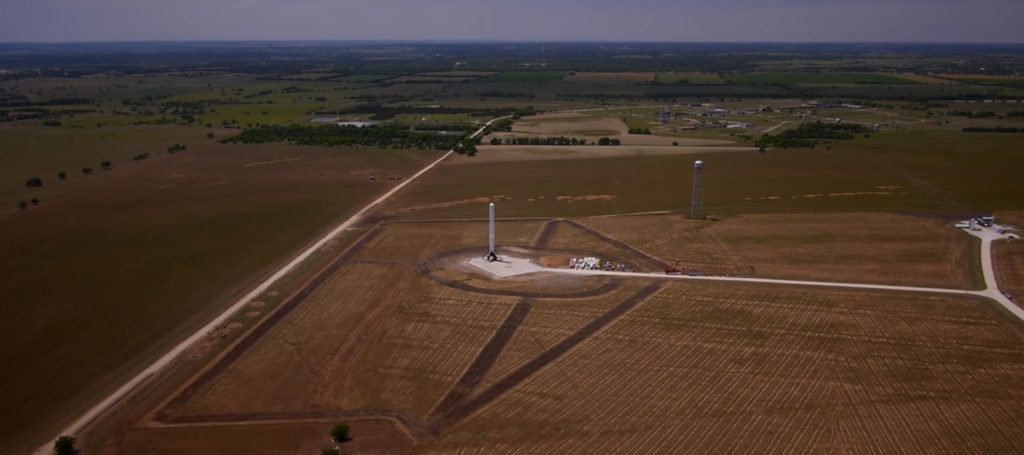

News
SpaceX begins huge dirt pile removal to pave way for BFR spaceship hop tests
After more than two years of silence, SpaceX has taken the first major tangible steps towards the construction of a dedicated South Texas rocket testing facility.
In anticipation of a full-scale BFR spaceship (BFS) hop test campaign that could begin as early as late 2019, local contractors and a smattering of SpaceX employees have begun to earnestly break down and repurpose a large quantity of dirt – known as a surcharge pile – to allow the construction of real facilities to begin.
Documented as of late by a handful of interested local observers and another subset of less local but equally interested followers, SpaceX’s prospective South Texas test and launch facilities have experienced a near-unprecedented burst of activity over the last two months, most notably including the arrival of a small fleet of heavy machinery and construction contractors at a site SpaceX has been working on for three years.
After ~36 months of dead silence, this activity correlates well with recent comments from SpaceX executives Elon Musk and Gwynne Shotwell indicating that the company is still targeting inaugural BFR spaceship hop tests sometime near the end of 2019.
Shotwell: think we’ll be “hopping” the second stage of BFR (the BFS) late next year. #DARPA60
— Jeff Foust (@jeff_foust) September 6, 2018
The infrastructure needed for those early tests could be quite sparse depending on the status of the BFR hardware to be ‘hopped’ – Falcon 9’s Grasshopper and F9R test campaigns, for example, operated off of a tiny concrete pad with extremely minimalist ground support equipment (GSE). Photos from a number of videos SpaceX posted during those crafts’ 2012-2014 series of hop tests demonstrate this minimum well, although chances are good that the company will build up Boca Chica a bit beyond the test pad used for Falcon 9 booster recovery R&D.
- F9R seen just before liftoff for a 2014 hop test at SpaceX’s McGregor, TX test facilities. (SpaceX)
- Just the bare necessities. (SpaceX)
SpaceX’s Grasshopper and F9R hop tests took place exclusively at the company’s well-established McGregor, Texas testing facilities, offering a range of large hangars, three operational Merlin 1D and Vacuum test bays, and dedicated stands for integrated first and second stage static-fire tests, among countless other rocketry-related amenities. The secluded South Texas coastal region where SpaceX wants to test – if not launch – integrated BFRs has none of McGregor’s preexisting infrastructure, however – anything SpaceX needs will have to be built from scratch on-site.
There is activity. pic.twitter.com/A8JYw6vdW6
— Nehkara (@Nehkara) October 13, 2018
Thus far, almost no real structures have been constructed, aside from a small-ish sheet metal shed that was literally built around a huge crane that arrived on SpaceX property a few months prior. Over the last two or so years, all activity at the South Texas site clustered specifically around a plot where two large radio dishes – and eventually cryogenic storage tanks – were delivered, installed, and/or stored. However, the actual site of the pad SpaceX originally planned to launch Falcon 9 and Heavy from is a mile or two East of that highly visible development, the same location where a flurry of activity has begun in the last month.
- A map showing several locations SpaceX planned (as of 2014) to develop.
- SpaceX’s proposed launch site (right) and the currently location of radar dishes, a large crane, and several propellant tanks. (Google)
In 2015, SpaceX trucked in several hundred thousand tons of dirt to be packed on top of the site where the company eventually planned to build a large Falcon integration hangar and then left for several years to crush the softer marshlands beneath it into firm submission. That time appears to be up, as the work now ongoing at that site is focused on removing that surcharging dirt now that the soil beneath it is stable enough to host heavy, long-term structures like a rocket launch pad.
Most of that massive dirt pile will likely remain at SpaceX’s South Texas property, to be used as a basic construction material as the company begins to build some semblance of the facility described in its approved 2014 environmental impact assessment. As it takes shape, it will become clear just how closely SpaceX is sticking to those original plans. BFR hop tests could begin by late 2019 if prototype spaceship construction – already in work at a tent in Port of Los Angeles – proceeds smoothly.
For prompt updates, on-the-ground perspectives, and unique glimpses of SpaceX’s rocket recovery fleet check out our brand new LaunchPad and LandingZone newsletters!

News
Tesla aims to combat common Full Self-Driving problem with new patent
Tesla writes in the patent that its autonomous and semi-autonomous vehicles are heavily reliant on camera systems to navigate and interact with their environment.

Tesla is aiming to combat a common Full Self-Driving problem with a new patent.
One issue with Tesla’s vision-based approach is that sunlight glare can become a troublesome element of everyday travel. Full Self-Driving is certainly an amazing technology, but there are still things Tesla is aiming to figure out with its development.
Unfortunately, it is extremely difficult to get around this issue, and even humans need ways to combat it when they’re driving, as we commonly use sunglasses or sun visors to give us better visibility.
Cameras obviously do not have these ways to fight sunglare, but a new patent Tesla recently had published aims to fight this through a “glare shield.”
Tesla writes in the patent that its autonomous and semi-autonomous vehicles are heavily reliant on camera systems to navigate and interact with their environment.

The ability to see surroundings is crucial for accurate performance, and glare is one element of interference that has yet to be confronted.
Tesla described the patent, which will utilize “a textured surface composed of an array of micro-cones, or cone-shaped formations, which serve to scatter incident light in various directions, thereby reducing glare and improving camera vision.”

The patent was first spotted by Not a Tesla App.
The design of the micro-cones is the first element of the puzzle to fight the excess glare. The patent says they are “optimized in size, angle, and orientation to minimize Total Hemispherical Reflectance (THR) and reflection penalty, enhancing the camera’s ability to accurately interpret visual data.”
Additionally, there is an electromechanical system for dynamic orientation adjustment, which will allow the micro-cones to move based on the angle of external light sources.
This is not the only thing Tesla is mulling to resolve issues with sunlight glare, as it has also worked on two other ways to combat the problem. One thing the company has discussed is a direct photon count.
CEO Elon Musk said during the Q2 Earnings Call:
“We use an approach which is direct photon count. When you see a processed image, so the image that goes from the sort of photon counter — the silicon photon counter — that then goes through a digital signal processor or image signal processor, that’s normally what happens. And then the image that you see looks all washed out, because if you point the camera at the sun, the post-processing of the photon counting washes things out.”
Future Hardware iterations, like Hardware 5 and Hardware 6, could also integrate better solutions for the sunglare issue, such as neutral density filters or heated lenses, aiming to solve glare more effectively.
Elon Musk
Delaware Supreme Court reinstates Elon Musk’s 2018 Tesla CEO pay package
The unanimous decision criticized the prior total rescission as “improper and inequitable,” arguing that it left Musk uncompensated for six years of transformative leadership at Tesla.

The Delaware Supreme Court has overturned a lower court ruling, reinstating Elon Musk’s 2018 compensation package originally valued at $56 billion but now worth approximately $139 billion due to Tesla’s soaring stock price.
The unanimous decision criticized the prior total rescission as “improper and inequitable,” arguing that it left Musk uncompensated for six years of transformative leadership at Tesla. Musk quickly celebrated the outcome on X, stating that he felt “vindicated.” He also shared his gratitude to TSLA shareholders.
Delaware Supreme Court makes a decision
In a 49-page ruling Friday, the Delaware Supreme Court reversed Chancellor Kathaleen McCormick’s 2024 decision that voided the 2018 package over alleged board conflicts and inadequate shareholder disclosures. The high court acknowledged varying views on liability but agreed rescission was excessive, stating it “leaves Musk uncompensated for his time and efforts over a period of six years.”
The 2018 plan granted Musk options on about 304 million shares upon hitting aggressive milestones, all of which were achieved ahead of time. Shareholders overwhelmingly approved it initially in 2018 and ratified it once again in 2024 after the Delaware lower court struck it down. The case against Musk’s 2018 pay package was filed by plaintiff Richard Tornetta, who held just nine shares when the compensation plan was approved.
A hard-fought victory
As noted in a Reuters report, Tesla’s win avoids a potential $26 billion earnings hit from replacing the award at current prices. Tesla, now Texas-incorporated, had hedged with interim plans, including a November 2025 shareholder-approved package potentially worth $878 billion tied to Robotaxi and Optimus goals and other extremely aggressive operational milestones.
The saga surrounding Elon Musk’s 2018 pay package ultimately damaged Delaware’s corporate appeal, prompting a number of high-profile firms, such as Dropbox, Roblox, Trade Desk, and Coinbase, to follow Tesla’s exodus out of the state. What added more fuel to the issue was the fact that Tornetta’s legal team, following the lower court’s 2024 decision, demanded a fee request of more than $5.1 billion worth of TSLA stock, which was equal to an hourly rate of over $200,000.
Delaware Supreme Court Elon Musk 2018 Pay Package by Simon Alvarez
News
Tesla Cybercab tests are going on overdrive with production-ready units
Tesla is ramping its real-world tests of the Cybercab, with multiple sightings of the vehicle being reported across social media this week.

Tesla is ramping its real-world tests of the Cybercab, with multiple sightings of the autonomous two-seater being reported across social media this week. Based on videos of the vehicle that have been shared online, it appears that Cybercab tests are underway across multiple states.
Recent Cybercab sightings
Reports of Cybercab tests have ramped this week, with a vehicle that looked like a production-ready prototype being spotted at Apple’s Visitor Center in California. The vehicle in this sighting was interesting as it was equipped with a steering wheel. The vehicle also featured some changes to the design of its brake lights.
The Cybercab was also filmed testing at the Fremont factory’s test track, which also seemed to involve a vehicle that looked production-ready. This also seemed to be the case for a Cybercab that was spotted in Austin, Texas, which happened to be undergoing real-world tests. Overall, these sightings suggest that Cybercab testing is fully underway, and the vehicle is really moving towards production.
Production design all but finalized?
Recently, a near-production-ready Cybercab was showcased at Tesla’s Santana Row showroom in San Jose. The vehicle was equipped with frameless windows, dual windshield wipers, powered butterfly door struts, an extended front splitter, an updated lightbar, new wheel covers, and a license plate bracket. Interior updates include redesigned dash/door panels, refined seats with center cupholders, updated carpet, and what appeared to be improved legroom.
There seems to be a pretty good chance that the Cybercab’s design has been all but finalized, at least considering Elon Musk’s comments at the 2025 Annual Shareholder Meeting. During the event, Musk confirmed that the vehicle will enter production around April 2026, and its production targets will be quite ambitious.












